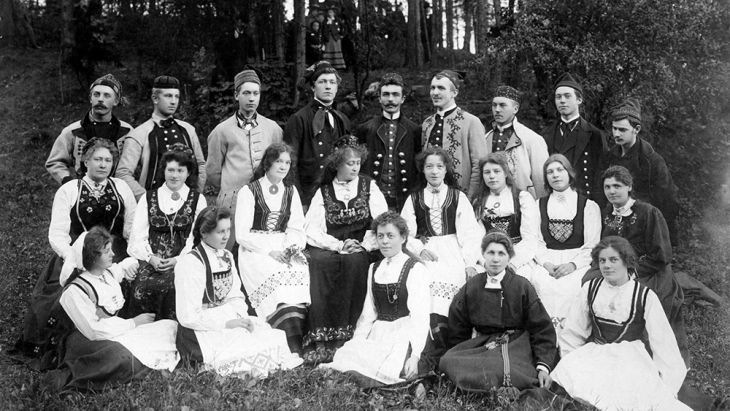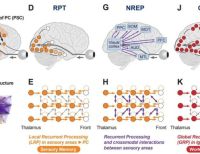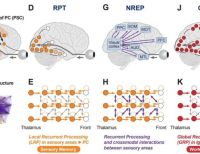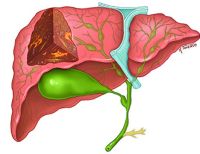Farmers’ youth were to “Norwegianise” Oslo through folk dance and theatre
In the 1900s, the Farmers' Youth Society gave young people who migrated from the countryside a home in the Norwegian capital. The youth also became part of an ideological project.
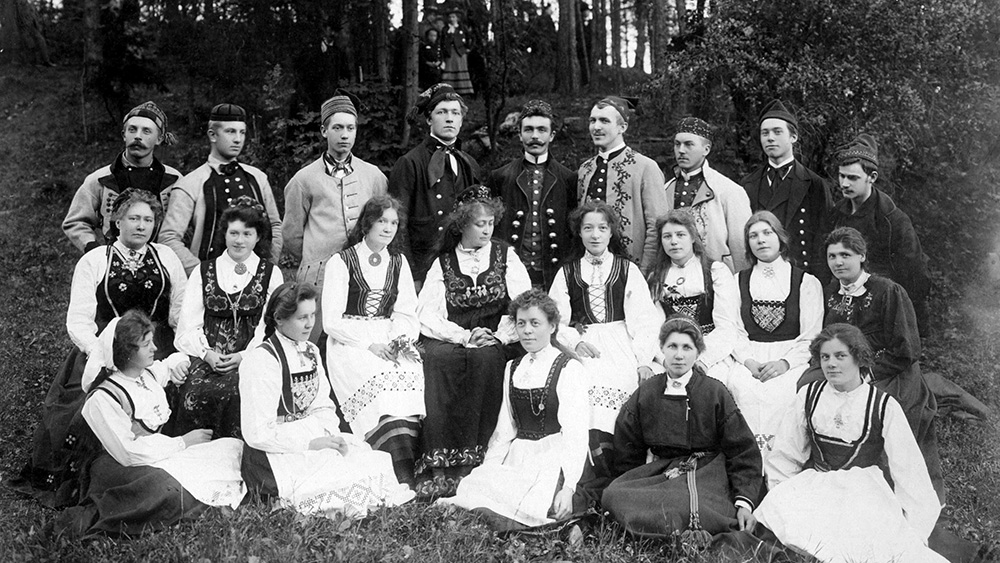
NATIONAL COSTUMES AND FOLK DANCE: At Bygdøy, the farmer's youth met to dance. Here is the Farmer Youth Society's dance ring, with Hulda Garborg in the middle, at the autumn festival at the Norwegian Folk Museum in 1902.
Photo:
Norsk Folkemuseum.In the 1920s, there were plenty of urban activities for young people in the Norwegian capital. They could go to a jazz concert or to the theatre, have a beer at a restaurant or go dancing.
For young people from rural areas, the Farmers' Youth Society (Bondeungdomslaget - BUL) sought to tempt them with activities reminiscent of home: folk dance, theatre performed in local dialects, traditional Norwegian cuisine at ‘Kaffistova’, or cross-country skiing in the surrounding hills.
“Many were concerned that young people from rural areas were having a difficult time and that they would be lured in by temptations of the big city such as restaurant life and alcohol. That is why the Farmers' Youth Society wanted to create a home for them in Oslo,” says historian of ideas Joel Johansson.
In a new doctoral thesis, Johansson has investigated the ideas and emotions that characterised the Farmers' Youth Society from its inception in 1899 and throughout the first forty years up to 1939.
He finds strong emotions related to the home village and the nation – and sees that the members are part of a political and ideological project of their time.
Norwegian language dispute and ‘Norwegianness’
Norway undergoes major changes around the turn of the century. The country becomes an independent nation, cities are growing, new jobs are created, and more and more people get educated at the University of Oslo. Young people are drawn to the cities to take part in this exciting development. However, not everyone looks kindly on the new townspeople.
“For example, opera singer Lona Gulowsen Gyldenkrone tells Aftenposten newspaper how worried she is about all these boasting, uncouth upstarts from the provinces flooding the capital. When they speak their dialects, she thinks it is just as unbearable as listening to as a squeaky pram,” says Johansson.
 STUDYING TENSIONS BETWEEN THE URBAN AND THE RURAL: According to historian of ideas Joel Johansson, the Farmer's Youth Society was an urban leisure organization with an ambivalent relationship to Oslo. Photo: UiO.
STUDYING TENSIONS BETWEEN THE URBAN AND THE RURAL: According to historian of ideas Joel Johansson, the Farmer's Youth Society was an urban leisure organization with an ambivalent relationship to Oslo. Photo: UiO.
Throughout the 1800s, Norway’s Youth Society had established associations all over Norway and united young people through dance and sports. They now saw that the capital also needed a youth association, and the Farmers' Youth Society was established in Oslo, then named Kristiania, in 1899.
“The Society realised that there was a need to support young people from rural areas. The purpose of the activities organised by the Farmers' Youth Society was to create a connection to the places they had left behind, so that they wouldn’t get homesick.”
At the same time, they were part of a large youth movement, and not least the ‘Norwegianness movement’ (norskdom in Norwegian).
“The movement aimed to create a more Norwegian Norway, with less influence from the Danish. Language was a key issue: They fought for Norwegian Nynorsk, or ‘language of the land’ (landsmål in Norwegian) as it was called at the time.”
The writer Ivar Aasen, who a few years earlier had created Norwegian Nynorsk based on Norwegian dialects, was the household idol of the movement, and member magazines published by the Farmers’ Youth Society and Norway’s Youth Society were written in various forms of Nynorsk. In these magazines, one could read about how the nation was to find its true Norwegian identity.
“It was believed that the real Norwegians primarily existed in the countryside. When it comes to the history of ideas, this is something that applies in other countries as well.”
Therefore, the farmers’ youth were to be a role model for the townspeople.
The Norwegian Theatre used as a weapon to Norwegianise
In order to achieve the goal of a more Norwegian Oslo, the Farmers’ Youth Society employed several strategies. One of these was the Norwegian Theatre.
“The Farmers’ Youth Society describes the theatre as one of the most important forces in the struggle, and in one edition of the society’s member magazine, the management writes ‘It is certain: When the day comes that the Norwegian language has become the only standard language in Norway, it will be remembered that the Norwegian Theatre has been one of our best weapons, one of our best and most combat-willing phalanxes in the struggle’.”
Hulda Garborg was an important ideologue in the movement, and it was her theatre company that moved into the Farmers’ Youth Society’s basement in the years before the theatre established itself in a building in Stortingsgaten 16 – and later Kristian IV’s Street.
“The stories of the plays were often set in the countryside, and Norwegian Nynorsk was used. This was a way of transporting oneself to the countryside, despite being in the middle of Oslo.”
The theatre was just one of several spaces the Farmers’ Youth Society created in the city – they also attracted young people by offering coffee, folk dance and sports.
Kaffistova and Bygdøy were important spaces
Kaffistova, a café which is still open today, became an important meeting place for young people from rural areas. Alcohol was not on offer, but you could buy a cup of coffee or traditional Norwegian food, such as potato dumplings or cured mutton, and have it served by women dressed in national costume, while not having to worry about speaking your own dialect.
“They tried to create a safe environment and a sense of the countryside home, which the female serving staff were meant to contribute to.”
Two emotions in particular dominate the sources stemming from the Farmers’ Youth Society. In addition to a homely feeling of being back in the countryside, a distinctive form of joy called hugnad is described.
“It is a youthful joy, which is very closely associated with being Norwegian. It is strong, decent and unproblematic – especially when compared to those who drank alcohol and danced – those people experienced a false, illusory joy.”
Folk dancing in particular was an activity in which one could experience hugnad. When young members of the Farmers’ Youth Society danced at Leikarvollen on the Bygdøy peninsula, the feelings of joy were also linked to politics. The audience at Leikarvollen was the bourgeoisie of Oslo, and folk dance was therefore one of the means towards achieving Norwegianisation.
“Instead of mocking cultural expressions from the countryside, the bourgeoisie were to be impressed – and influenced.”
 A FEELING OF HOME: Kaffistova, the Farmers' Youth Society's café, was to offer young people a sober alternative to the restaurant life of the big city. Here they were served home cooking and coffee, while the conversation was in dialect. Photo: Norsk Folkemuseum.
A FEELING OF HOME: Kaffistova, the Farmers' Youth Society's café, was to offer young people a sober alternative to the restaurant life of the big city. Here they were served home cooking and coffee, while the conversation was in dialect. Photo: Norsk Folkemuseum.
Healthy Norwegian youth with a talent for sports
The 1920s were the Farmers’ Youth Society’s heyday, and the organization had approximately 2000 members in 1921. Despite it having fewer members today, it continues to be an active society and operates its business interests at Bøndenes hus in Rozenkrantz’ street in addition to leisure activities. Many people may recognise the Farmers’ Youth Society acronym BUL from their team jerseys at sporting events.
“Sport has always been important to the Farmers’ Youth Society,” says Johansson, and explains:
“It is connected to the ideal of being healthy. Young people had a lot of time on their hands – they needed to be raised and shaped through healthy activities, instead of sitting around drinking in the restaurants.”
The youth soon found role models in members who became Olympic champions, such as cross-country and combined skier Johan Grøttumsbråten, of whom you can see a statue outside Sporten at Frognerseteren.
“One had an image of the farmers’ youth as being very healthy. Cross-country skiing in Nordmarka, the hills surrounding the capital, was also seen as something one should partake in, even though not everyone used to do cross-country skiing in their home village.”
The sports team did cross-country skiing, but also orienteering, running and track-and-field. They built two cabins in Nordmarka: Bondehytta and Røkleivhytta.
“They saw the cabins as Norwegian outposts, but also as a genuine substitute for their home village. This is where one could feel at home – in the forests that look like home.”
Identity as Farmers’ youth originated in the city
The members of the Farmers' Youth Society were not necessarily from farming families. Johansson sees that there are many notions about farmers and the countryside that shape the ‘farmers’ youth’.
“I would say that they became farmers’ youth in Oslo – the term was used to distinguish them from urban youth.”
He also sees that it is the notion of a home village that unites the young people, rather than where they actually come from.
“Many come from Western Norway, a lot from Eastern Norway, some from Sweden, some from Denmark. What most of them have in common is that they come from large farms – these were the kids who could afford to leave. The labour movement often called them the farming nobility.”
Therefore, it was not the case that they arrived in the big city with similar experiences. As a result, they were to be shaped according to an ideal: healthy and not least Norwegian youth who found joy in edifying activities such as dance and sports.
 STRONG FEELINGS FOR THE NATION: The Farmers' Youth Society wanted the people in Oslo to be impressed and shaped by the young people from the countryside, with their healthy lifestyle, their national costumes and their dialects. Photo: L. Szacinski/Oslo Museum.
STRONG FEELINGS FOR THE NATION: The Farmers' Youth Society wanted the people in Oslo to be impressed and shaped by the young people from the countryside, with their healthy lifestyle, their national costumes and their dialects. Photo: L. Szacinski/Oslo Museum.
Nationalistic sentiments – must be understood in context
Johansson not only looks at what emotions the young people and leaders of the Farmers' Youth Society describe, but also what such emotions mean.
“The emotional aspect is not something innocent, detached from the political. These are closely related, and emotions can be very valuable as political resources,” he emphasises.
“Today, many people associate the ideology of nationalism and Norwegianness with something negative. Were there also problematic aspects to the ideas they promoted?”
“You have to view it in context. In the thirties, people competed to be as nationalistic as possible. This didn’t just occur in the Farmers' Youth Society, the labour movement was also concerned with nationalist sentiments.”
The Farmers' Youth Society elevated the farmer as being specially connected to the nation.
“This is rhetoric that also exists in other political camps and may resemble thoughts about blut und boden (blood and soil) within German Nazism at the same time.”
The historian of ideas hopes his research can broaden the understanding of the emotions that ran strong in the Farmers' Youth Society.
“The term ‘home village’ can also be rather problematic. What some see as a home is also something others can be excluded from. The same is true when talking about nationalism. If something is to be Norwegianised, then something must be removed. When they were sceptical of the variety show culture, for example, they described it as international, with its elements of jazz and African American culture.”
At the same time, Johansson emphasises that the Farmers' Youth Society had a democratic foundation, in contrast to anti-democratic movements that would grow leading up to the outbreak of World War II.
“No racial rhetoric is found in the Farmers' Youth Society either. They are concerned with Norwegiannes, but without strong opinions about Jews or other racial thinking, something which was present in the youth league of the Norwegian national socialist party Nasjonal Samling.
Source: Johansson, Joel (2022). Stadens landsbygd. Emotionella rumsligheter inom Bondeungdomslaget i Oslo 1899–1939. Doctoral thesis, Department of Philosophy, Classics, History of Art and Ideas.
